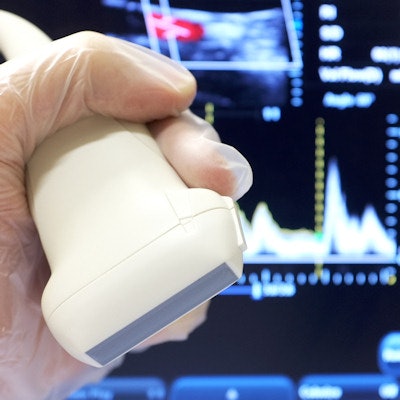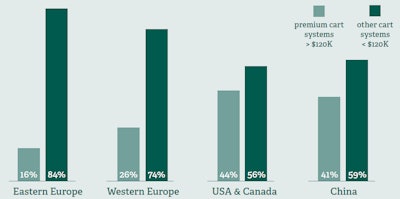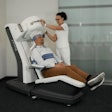
The European market for new ultrasound equipment continued to grow steadily in 2017, with overall sales revenues increasing by 4%. This was driven by higher growth from the Polish and Nordic markets, which was offset by contractions and lower growth from the German, Italian, French, and U.K. markets. The total European market reached $1.4 billion in 2017 with Germany, France, and Italy as the largest markets.
The opportunity for long-term growth in equipment sales remains, however, cyclical tender activity and healthcare budgets continue to drive short-term fluctuations.
While the European market is expected to continue investing in new ultrasound equipment, there are some significant regional purchasing trends. One of these is the lower levels of premium ultrasound purchases by European healthcare institutions. As a proportion of overall expenditure on ultrasound equipment, the European countries purchase significantly fewer premium systems relative to international counterparts such as North America and China. Premium systems accounted for 26% of the Western European market in 2017, 18% lower than North America and 15% less than China. In Eastern Europe, premium systems accounted for 16% of the ultrasound market, which is 2.9 times less than North America and 2.7 times less than China. The Eastern Europe region has the lowest expenditure on premium systems against all metrics, despite having some of the fastest growing markets on a global basis.
 Global market for premium cart ultrasound systems; proportion of 2017 revenues. Source: Signify Research.
Global market for premium cart ultrasound systems; proportion of 2017 revenues. Source: Signify Research.This is an important trend because the latest advances in ultrasound technology and product development are typically found on premium and high-end systems. These advances include better image quality, greater processing power, advanced clinical applications, integration of artificial intelligence (AI), and improvements to ergonomics and workflow. For example, improved hardware architectures with increased processing power, coupled with advances in probe technology, have enabled systems to deliver greater image resolution as well as deeper tissue penetration, without compromising on diagnostic quality. Fusion imaging capability is still only generally available on premium and high-end systems.
So, are European ultrasound users losing out? Some of the implications of Europe's lower access to premium ultrasound systems may include the following:
- Longer exam times: Premium ultrasound systems typically have the latest workflow and automation capabilities, helping to reduce exam times, particularly for more complex exams.
- Lower diagnostic accuracy: Premium ultrasound systems offer the highest image quality and the most advanced diagnostic tools.
- Greater diagnostic inconsistency: Premium ultrasound systems have advanced clinical applications, such as tools for automated quantification of imaging features, helping to reduce inter- and intraobserver variability.
- Poorer user experience: Premium ultrasound systems feature the latest ergonomic and user interface designs to reduce user fatigue and repetitive motions.
- Less use of ultrasound: Premium ultrasound systems have the best image quality and the latest features, enabling them to be used in an expanding range of clinical applications that have previously used other imaging modalities.
- Less use of multimodality imaging: Fusion imaging is typically only available on premium ultrasound systems.
Some of the reasons behind this subdued purchasing activity for premium ultrasound include pricing pressures from group purchasing arrangements, product attractiveness due to feature migration, tighter government healthcare budgets, and cost containment.
Product feature migration has been a characteristic of the ultrasound market for many years. This is where the latest advances in product development are initially launched in premium systems and subsequently made available on midrange and lower-cost systems in the following years. This has successfully made affordable ultrasound machines more appealing, although it has somewhat cannibalized the upper end of the market. OEMs need to continually innovate and add new functionality to ensure their premium systems remain attractive in order to support premium sales. While there have been relatively few new innovations for premium ultrasound systems in recent years, we are observing an increasing pace of product advances, particularly through introducing AI and improving clinical workflows. Time will tell if these developments are enough to tempt European customers.
Stuart Kusta is senior analyst at Signify Research, a U.K.-based independent supplier of market intelligence and consultancy to the global healthcare technology industry.
Originally published in ECR Today on 3 March 2019.
Copyright © 2019 European Society of Radiology



















